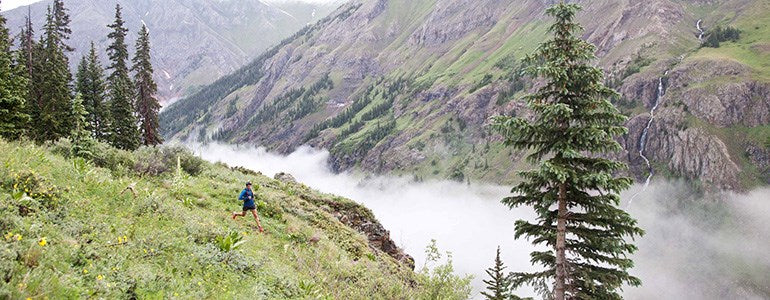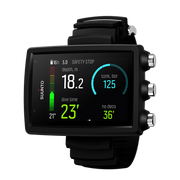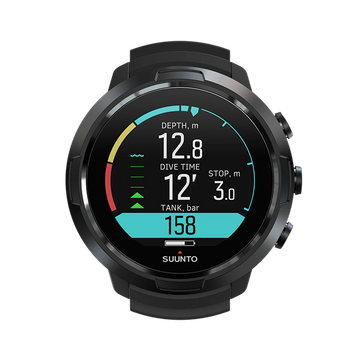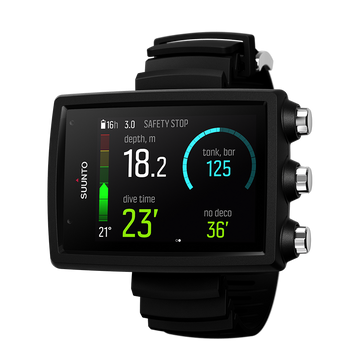

Suunto-blogg

Climb every (4,000 m) mountain
How’s the adventure been so far? It’s just so much fun. The weather has been great so far and I’m doing something almost every day. Sometimes of course there are days you are a little tired but that’s normal. I don’t feel wasted. I am super motivated and I am super happy. I have to say even if I don’t climb all 82 summits, by the end I would still be totally happy. I had just a great time so far. It’s just very cool being in the mountains, meeting people, going climbing, running cycling etc. The supporter is my best friend Daniel Mader.
Peak 41 of Ueli Steck's 82 Summit project. The Zinalrothorn above Zermatt marks the halfway point of his goal to climb all 82 4000 meter peaks in the Alps, using human-powered transport alone. ©PatitucciPhotoThe hardest part? I don’t know. When we did the Monterosa traverse, which was 18 peaks in a day, Andreas Steindel and I did get a little tired at the end! He is a mountain guide and part of the Swiss ski-mountaineering team. He knows the area very well so we just linked all these peaks. It was a great day out. I also climbed later the Weisshorn Bishorn in very bad weather. It was icy and snowy. I was completely in the fog. That was not a great moment.Has this project taught you anything new? Yes you don’t have to go far away to have a great time. Also in the Alps you can find still great challenges!What inspired you to create and do this project?It was the challenge of the whole journey. Being able to move so much and also the challenge with the weather and the conditions on the mountains!How has your climbing philosophy evolved? Before I was just focused on performance and pushing the limits in alpinism, recently in the Himalaya on the high peaks. But I am also not 20 anymore! I try to find the right balance in my life. I know I pushed myself to the edge, taking risk and pushing the limits on the 8000 m peaks. This is a one-way street. You will not survive this long-term. So of course I would like to go back to the Himalaya and climb 8,000 m peaks. But in the same style that I Annapurna? No, this I will not repeat. This game you survive only once in life.... But there are still great adventures to live!!!*Note: This interview was made with Ueli before last Wednesday’s accident in which Dutch climber Martijn Seuren died on the Rochefort Arete in the Mt Blanc massif. Contrary to some online reports, he was not part of Ueli’s project, but Ueli was at the scene afterwards. You can read his statement here.

Competition Freediving: the secret to doing well
Will Trubridge explains the importance of psychological strength in freediving competitions – and why having a poker face is a very useful skill. To the observer, freediving is all about serenity and calmness – a peaceful interaction with the underwater world. It is exactly all these things, which is why competition freediving presents such a unique challenge, says Will Trubridge.
“The conditions of a competition are slightly different to a world record attempt. In a competition you have an official preset time and there's a lot more people around – spectators and media. It's not as controllable as with a world record attempt,” he says.
Trubridge surfaces after a competition dive at Dean's Blue Hole ©zooom.at/Samo VidicThe key ingredient to success is to be relaxed he says, which is much harder to achieve in the contest environment. “With other sports you can use the nerves and the anxiety which generates adrenalin to your advantage. In freediving it's completely detrimental.”The reason for this is the affect it has on heart rate. Stress and anxiety raises the heart rate. To be successful, freedivers need to have the lowest pulse possible to conserve oxygen. Trubridge is currently preparing for the AIDA Apnea Depth World Championship in Cyprus this September after a successful spring in which he won all titles and set a new competition No Fins personal best (PB) of 98m in Colombia. He says he’s getting better at handling the stresses of contests.
“I’m feeling really motivated for [Cyprus]. The lesson I've been learning a lot this year is the importance of being patient and taking my time and not feeling obliged to do a dive.”He also says that mind games play a part. When going for a world record or when competing at his own Suunto Vertical Blue contest, a freediver can have multiple attempts over several days. But in the world champs, they get just one chance. And that involves some psychological battles. “You announce your dive on that day. If something goes wrong, then you don't have a second chance. It creates more of an element of chance. There is also a lot of sleuthing and spying to find out what other freedivers have done in their training to gauge how they're performing, and using that information to make pronouncements.”
Watch as Will Trubridge attempts to break his own 102m record.
He says that if he underestimates a competitor’s ability and sets himself a target that’s too low, he risks losing, but set the target too high and the risk is to over-stretch and fail. “It creates an element of a poker game in the announcements themselves!” he adds. Trubridge says he’s can’t wait for the contest to begin. “I've never been to Cyprus. My goals are to do well in all three disciplines. I have the world records in no fins and free immersion. I would like to do my best at winning gold in those two disciplines and do as best as I can in constant weight.”We wish him the best of luck.

ORIENTATE YOURSELF WITH A COMPASS
Using a map and compass may seem antiquated but it could save your life. So when traveling in the backcountry it is always a good idea to carry a map and a compass with you even if you have a GPS device. But they are only good if you know how to use them!
1. ORIENTATE YOURSELF
With map-reading the most important thing is to orientate yourself on the map and then to always keep track of where you are on the map. Use the features on the map to find your location. Look at the big features first, like peaks, lakes, roads and then look at the smaller details such as buildings, footpaths or small rivers etc.
Use the altimeter function to help pinpoint your location. Once you know your height you can use the contour lines to fix where you are more precisely. Spend some time making sure the features on the ground match those on the map. It’s very easy to convince yourself otherwise! Top tip: it can take a long time to orientate yourself. So once you’ve done it, fold the map in such a way that your location is visible. To be even more efficient, do what orienteering racers do: carry the map with your thumb on your position.
2. ORIENTATING THE MAP
To be able to read a map, you must first orient it. Turn your map into a position in which the details on the map correspond with the landscape in front of you. The orientation of a map is the key to reconciling the map with the terrain.
To orientate the map, place the compass on the map and rotate the map to align the magnetic compass needle with the northerly grid lines on the map, making sure the red end of the needle points to north on the map.
Also read: Tutorial Tuesday: Where am I? Determining your location with an Ambit.

Go mountaineering to stay fresh, says Kilian
With two big victories this summer, trail running legend Kilian Jornet is planning different mountain adventures to mix it up and stay fresh.
Breaking records is what Kilian Jornet has done over and over again. Aside from setting speed records on giant mountains all over the world, the 27-year-old Spaniard has busted a number of ultra marathon race records. In June, he won the iconic Mount Marathon Race in Alaska, breaking the men’s course record in the process.
Then, only a couple of weeks later, he won the tough Hardrock 100 Race, breaking the counter clockwise record after winning and breaking the clockwise course record just the previous year. “I have been racing for 15 years and I have been doing a lot of races and what attracts me to a race now is not only that the level of competition is high, but that everything else around it is nice too,” Kilian says. “Both the Mount Marathon Race and Hardrock 100 races have amazing trail and incredible ambience.”
The Hardock 100. Photo from file ©Blake Wood.
Rather than more racing this summer, if the weather stays good Kilian aims to carry out two mountaineering projects in the European Alps. Mountaineering is one of the key ways Kilian likes to recovery after big tough running races and stay mentally fresh, which is something he says is crucial for all athletes. Click here to find out about new recovery features for Ambit3 watches. “To help me recover mentally from racing, I like to do some mountaineering activities to feel different feelings than just running,” he says. “I ran less than 200 km in the build up to Hardrock because I was climbing instead.
Midnightsun Ersfjordtraversen
Ersfjord traversen is one of the most beautiful ridges crossings I have ever done. A scrambling, climbing and some glaciers crossing on the side of the fjords.Enjoy the video!!#Alpinrunning #Expandyourplayground
Posted by Kilian Jornet on Monday, 20 July 2015
“I was keeping myself good through mountaineering so when I came to the race I was mentally fresh and physically prepared. If you focus too hard on one thing for too long you can get tired of it.“You see people who are doing a lot of long races and who keep this up for one or two years and then, boom, they’re down, injured and no longer reach a good level. It’s important to never do too many long races every year because after one, two or three years it can be really hard to recover. I think 200 or 300 miles a year is the limit.”
Main image shared via Kilian Jornet

SIX USEFUL TIPS FOR SWIM-RUNNING
Swim run events are great endurance challenges – and a super fun way to enjoy a summer’s day. The number one event in the world is the Ötillö Swim Run World Championship in Stockholm’s archipelago in September. In Ötillö, teams of two will open-water swim and trail run a distance of 75 km across 26 islands.
To make the challenge even bigger, the competitors have to carry everything they need with them through out the race, which results in some interesting and novel gear solutions – they swim with their running shoes and run in wetsuits.
German Armin Hummel and Finn Juha Lindfors are preparing for their third attempt at one of the toughest endurance challenges in the world.
Here Armin and Juha share six useful tips to get you through your swim-run more smoothly. Enjoy!
Less is more
“Focus on what is really needed. In Ötillö, there are plenty of feed stations along the way – though sometimes it can be a lengthy break between them. Make sure you take enough drinks and food at the feed stations. It will be a looong day!”
“You can take some fuel with you if you can carry it, but at least for us there is no need for a hydration pack. A soft flask might be a good idea as it can be stuffed inside your wetsuit once empty. If you need to worry about a backpack you probably aren’t focusing on the race.”
Practice the transitions
“Train switching from running to swimming, and the other way round. There are many transitions and if you spend an extra minute at each, you end up losing a whole hour. Quick transitions are also a key reason to minimize equipment.”
Choose the right shoes
“Your swim-run shoes and socks should be fast drying and comfortable also when they are wet. Good grip on slippery, wet rocks is essential.”
“We have tried regular running shoes, trail running shoes and trail running shoes with spikes. Shoes without spikes seem to work better for us on the rocks. So this year both of us will be using trail running shoes without spikes.”
Don’t swim any extra distance
“Make sure you always look for the point where you will get out of water. Sometimes currents can be strong and, if you don´t look frequently, you can be off-course quite fast. Frequent position checks are important, especially on the long swims.”
“As it is a pair sport, it might also be enough that one navigates and the other one follows. Consider this especially, if one in your team is clearly a stronger swimmer.”
Consider using paddles and pull buoys
“The first time we raced Ötillö we used pull buoys to improve buoyancy, but last year we didn’t. We are still experimenting on this. We are not sure if there is a benefit for us. “
“Generally you need to be a really strong swimmer to swim without pull buoys, as shoes are on all the time. Well, some do actually take their shoes off at least for the longer swims.”
“Paddles give you extra force especially when there are waves and currents. However make sure you train with them before so your shoulders are used to the extra stress.”
Always move, never stop
“In Ötillö, there is lots of running. Try to maintain a steady pace rather than going superfast in the beginning and then not making it in the end. If you start walking, it is hard to get back to running again.”
“Make also sure that you don´t go off-track and follow the markers. We use our Suunto Ambit3’s to know the distances during stages.”
All photos by ÖTILLÖ14

Six runners win Suunto Ambit3 Run watches
After a huge response on Instagram and great feedback from professional running coaches Koop and Nick, the How do I run? contest has closed and six lucky runners have each won a Suunto Ambit3 Run watch.
Dozens of people shared clips of themselves running on Instagram to take part in our How do I run? contest. Carmichael Training System coaches Koop and Nick were run off their feet trying to analyze as many clips as possible.
Click here to read Koop and Nick’s 8 tips to become a better runner
© Droz Photo/Rosso Damien
The feedback from the coaches wasn’t only critical, much was positive. Many runners showed great overall form and need to work on one or two small points to improve their technique and performance. Check out the Instagram clips below for a taste of the action.
All of the runners who had their running analyzed by Koop and Nick went into a draw to win one of six Suunto Ambit3 Run watches. Instagrammers @stephenskinner6, @mbhuyko, @mish_glover, @faisnaini, @renatacavalleiro and @gofknxplore have each won a watch! Congratulations!
To also help runners improve their running performance, Suunto has released a new running performance level to its Ambit watches. The new feature is a combined measurement of physical fitness and running efficiency that guides training both during a single exercise and in the long run.
Click here to learn how to use Ambit3’s new running performance feature
Feedback from the coaches
More than a chance to win an excelent equipment, a chance to hear from the experts about how is my running! Love Suunto #SuuntoRun #skechersperformance #corracomonunca
A video posted by Renata Cavalleiro (@renatacavalleiro) on Jul 10, 2015 at 7:14pm PDT
Coach Nick says: You have a really nice forward lean when you're running. Definitely try to maintain that. Like a lot of runners, you are landing slightly on your heels and your feet are contacting the ground out in front of your body. If you can try to put your feet down underneath your hips that will let you move forward with greater efficiency. Bringing your contact point backwards a little should also make it easier to land on your mid foot rather than your heels, which is what you want. Mid foot strike directly beneath your hips. Keep your current forward lean and you're going to be faster!
In running, it doesn't matter whether you come in first, in the middle of the pack, or last. You can say, 'I have finished.' There is a lot of satisfaction in that. #SuuntoRun
A video posted by Muhammad Budiansyah (@mbhuyko) on Jul 13, 2015 at 5:41am PDT
Coach Koop says: You have very good form overall. Your gaze is straight forward, arms and shoulders are relaxed and you have a nice midfoot strike that is directly under your hips. I honestly would not change a thing here! Great work!
#suuntorun #suunto HELP ME! Urgent advices are needed to better run :) I would like to run at least 10 kms every 3 days however without GPS watch it is hard to measure my performance. I hope I will have a chance to win one!
A video posted by Évi Matola (@evimatola) on Jul 10, 2015 at 11:25am PDT
Coach Nick says: Your running technique is looking really good! Your foot strike is great. You're landing on the ball of your foot, and it appears that when your feet land, they're underneath your center of mass (hips). Those are definitely the most important pieces of the puzzle. Make sure you're leaning forward slightly while you run. And lastly, make sure that your arms aren't crossing in front of your body TOO much. Get all of your limbs moving in the direction you want to travel. Keep up the good work.































































